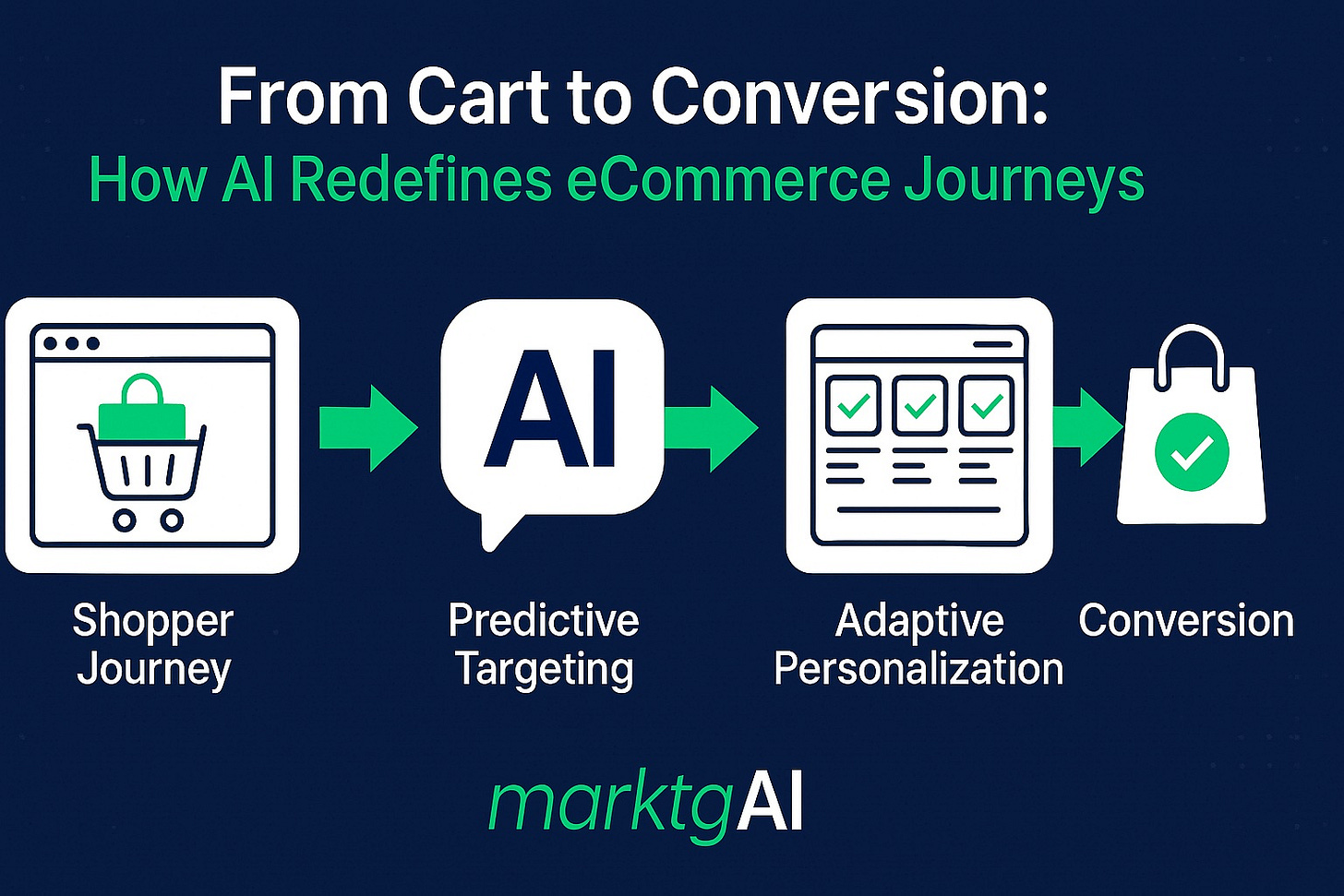From Cart to Conversion: How AI Is Quietly Rewriting the eCommerce Playbook
AI isn’t taking your job — it’s redesigning the entire customer journey.
The New eCommerce Reality
Once upon a time, shoppers followed a simple path: click, cart, checkout.
Those days are gone.
Today’s customer scrolls TikTok for inspiration, compares prices on Google, adds to cart on desktop, then finally checks out three days later on their phone — if you’re lucky.
To a marketer, that looks messy.
To AI, it’s a gold mine of intent signals.
Artificial intelligence is changing how eCommerce brands understand, predict, and influence customer behavior. It’s not just optimizing campaigns — it’s rearchitecting the entire shopping experience.
From Automation to Prediction
For the last decade, we called it “marketing automation.”
It was mostly a set of triggers:
If cart abandoned → send email after 3 hours.
Now? We’ve entered the predictive era.
AI doesn’t wait for behavior — it forecasts it.
It analyzes browsing data, timing, and buying patterns to anticipate what customers will do next.
That means marketing strategies shift from:
Old Way AI Way Reactive triggers Predictive models One-size-fits-all campaigns Real-time personalization Manual testing Continuous optimization Past behavior Future probability
This transition isn’t theoretical — it’s measurable.
Brands adopting AI-driven targeting are seeing up to 37% lower customer acquisition costs and 25% higher conversion rates in under 90 days.
Personalization That Actually Feels Personal
AI is finally delivering on the promise of 1:1 marketing.
Every shopper gets a unique experience — homepage layouts shift, product grids reorder, messages adapt, and offers change dynamically.
The result?
It no longer feels like automation.
It feels like attention.
For example:
Predictive email timing raises open rates by 20–30%.
Personalized chatbots lift conversion rates by 25–40%.
Dynamic pricing increases revenue by up to 25%, according to McKinsey.
It’s not about pushing harder — it’s about listening smarter.
The AI Flywheel: Predict, Personalize, Optimize
Think of modern eCommerce as a loop, not a funnel.
Predict what a shopper will want next.
Personalize the experience in real time.
Optimize based on what works best.
And then repeat — endlessly.
This loop compounds over time.
Every interaction becomes data.
Every data point becomes insight.
Every insight makes the next interaction smarter.
That’s the quiet revolution happening inside every thriving eCommerce business right now.
The P² Standard — Productivity + Precision
At marktgAI, we use one simple framework to measure AI’s impact: P².
Productivity — how efficiently teams operate.
Precision — how accurately campaigns hit their targets.
For eCommerce, it looks like this:
Metric Baseline AI-Enhanced Cart Abandonment ~70% ↓ to 55% Conversion Rate 2–3% ↑ to 4–5% ROAS 2.5x ↑ to 3.8x Manual Workload — ↓ 60% Customer Retention — ↑ 20–25%
The magic happens when you see both metrics rise together — faster execution and better results.
Ethics, Governance, and Human Oversight
AI may make decisions, but humans must set the boundaries.
Ethical frameworks (GDPR, CCPA, PIPEDA) aren’t hurdles — they’re the trust architecture that makes intelligent marketing sustainable.
Marketers should demand three things from their AI stack:
Explainability: You should always know why an AI chose an action.
Human approval: Creative direction, audience targeting, and budgets stay human-led.
Transparency: Customers deserve to know how data shapes their experience.
Trust isn’t an output — it’s a design feature.
The Next Frontier: Agentic Commerce
Soon, AI won’t just recommend — it will shop for you.
Imagine intelligent agents comparing prices, managing wish lists, and even checking out on your behalf.
To stay visible in this new landscape, brands must:
Structure product data cleanly (schema, metadata).
Maintain clear, transparent pricing.
Build a brand voice AI agents recognize as trustworthy.
Tomorrow’s competition won’t be for ad space — it’ll be for AI mindshare.
Practical Steps to Start Today
If you’re leading an eCommerce brand, start here:
Audit your data. Is it accurate, accessible, and unified?
Choose one predictive use case. Start small — cart recovery or send-time optimization.
Track both P² metrics. Time saved + ROI gained = proof of value.
Add explainability layers. Every AI decision should be reviewable.
Upskill your team. Understanding model logic is the new marketing literacy.
Final Thought
AI isn’t automating marketing — it’s amplifying it.
By transforming fragmented customer journeys into predictive, personalized experiences, AI helps marketers work smarter, not louder.
From cart to conversion, every click becomes a clue — and every clue, a chance to connect better.
The future of commerce is not algorithmic.
It’s human creativity, guided by intelligent systems.
💬 What to Think About
How “predictive” is your current marketing?
What data signals could you be missing today?
How will your brand stay visible when AI agents start shopping for your customers?
🧠 marktgAI | Human-led intelligence. AI-powered precision.
Follow for insights on AI Marketing, predictive growth, and the intersection of creativity and computation.
Tags:
#AI #eCommerce #Marketing #PredictiveAnalytics #DataDrivenMarketing #CustomerExperience #DigitalTransformation #SubstackWriters #AITrends2025


